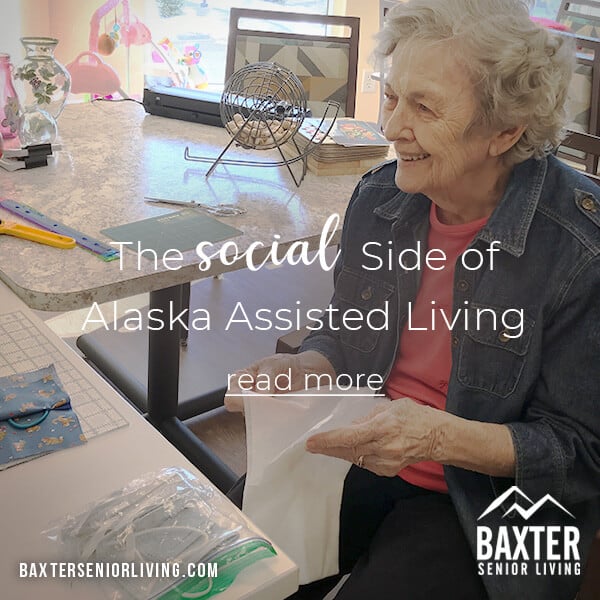Isolation and loneliness among seniors are among the leading causes of mental health problems, emotional difficulties, and premature death. Unfortunately, isolation becomes an all too common problem among many seniors living in an in-home care setting. As time passes, children and family move away, friends and spouses pass on, and our loved ones find themselves at home with fewer people to interact with. It is these moments when the conversation about senior living communities such as Baxter Senior Living often begins.
Assisted Living Misconceptions
Moving to senior living, or even considering the transition is often difficult for senior loved ones. Sadly, assisted living communities are typically surrounded by inaccurate misconceptions such as that they are a dreary hospital-like place where residents are relegated to their room all day to do nothing. Today’s senior living communities are just the opposite! Many senior living communities have modern amenities such as wellness centers, swimming pools, beauty salons, restaurant-style dining, and a host of other services and features that are not often available in the in-home care setting. An excellent assisted living facility will offer many activities to suit people’s needs, abilities, and interests. One of the most significant benefits of a senior living community is easy access to events, activities, and social interaction opportunities.
Unfortunately, the opportunities afforded at senior living communities do not always mitigate the challenges of encouraging a loved one to transition from their in-home care arrangements. Even those who are excited about (or at least on board with) relocating to a senior living community may still experience challenges when trying to integrate into a new living environment. The transition takes time, but there are ways to encourage socialization and involvement as your loved one transitions from in-home care to a senior living community.
Techniques for Increasing Senior Socialization
Remembering that every senior has a different level of social interaction that they are comfortable with is an important first step to increasing their desire to interact. In some cases, it may be necessary to get a little creative when encouraging your senior loved one to “get involved” around the senior living community. If you have parents, grandparents, or another family member who is hesitant to participate in the assisting living community’s activities, try a few of the below tips to help them adjust to an environment away from in-home care.
Let Them Go Slow
There are a few considerations to keep in mind while your loved one transitions into a new living environment. First, they likely have lived on their own or with a significant other for some time, and the concept of mingling with larger groups of peers (strangers) may be frightening. Also, it takes time for new residents of a community to integrate into already existing peer circles. It is essential to be patient with your loved one and resist the urge to persistently force them to mingle or interject themselves into situations they are not ready for. For them, this is akin to moving to a new school halfway through high school. Not only are they the “new kid,” but they are also coming to grips with what they have (or perceive they have) left behind concerning their freedom, independence, and previous, decades-long way of doing things. It may also mean they need to accept they are facing health issues and becoming dependent on someone other than themselves. This can be a difficult adjustment for a once fiercely independent person. Continue to encourage socialization as a senior living community affords many options likely not available should they continue with in-home care; However, remember to be gentle and patient as they accommodate.
Get a Feel for the Community
The adjustment period each person goes through will be different. For some, it may be days or weeks; for others, it could take months. Again, this will depend significantly on their current health and how outgoing they choose to or want to be. During this valuable time, take a moment to familiarize yourself with the community and get a feel for the types of groups and recreational options they have. Is there a knitting group that meets every afternoon to knit and share conversation? Does your mom love to knit? This could be an excellent opportunity for socialization. Is there a group of men who get together to play bingo on Saturday afternoons and discuss their view of current politics? Does this sound like your grandfather? Perhaps this group may be of interest to him down the road. Allowing yourself to learn a little about the dynamic of the residents and the activities offered to community members will help you look at all that is available and make suggestions that are likely to be considered.
Sometimes Solitary Activities Are OKAY
Besides learning about groups and group activities, take a moment to learn about any solitary activities the community may offer. The idea here is that merely getting your loved one to leave their room or apartment allows them the opportunity to interact if they choose to. Solitary activities often bring people into common areas such as libraries, community rooms, and dining rooms, and these are a great neutral environment where conversation and mingling can occur naturally.
Encourage Pre-existing Hobbies
Does your mom (or dad) love to bake? How about playing music or painting? Many senior communities have staff members (or prearranged activities) designed to help seniors continue to partake in hobbies they have always enjoyed. Often, participating in these activities will help people let their guard down and enjoy conversations with potential new peers who share a common interest.
Work with Alaska Senior Living Community Staff
When your senior loved one remains in an in-home care setting, there are minimal options for encouraging socialization without (sometimes) forcing them to get out of the home. This isn’t always comfortable or desirable. Many senior living communities have an activities director whose job centers around getting to know the residents and their interests. If your loved one seems resistant or disinterested in the current activity offerings, ask to meet with the activities director. Together you may be able to brainstorm ways to encourage them to get involved. Talk with the activities staff about your loved one’s interests and previous hobbies. Together you may be able to come up with additional activity options both your loved one and other community members may enjoy.
Relocating to a senior living community can be a complicated process for your senior loved one. They may never be “the life of the party,” but they will begin to socialize in their own way with time. At Baxter Senior Living, our caring and compassionate staff are here to help you, and your senior loved one through each step of the transition process. Residing in a senior living community like Baxter Senior Living allows for a variety of ways to socialize, interact, and form new friendships, all of which are vital to your loved one’s ongoing and continued health.


